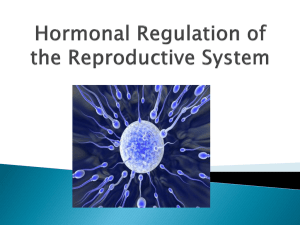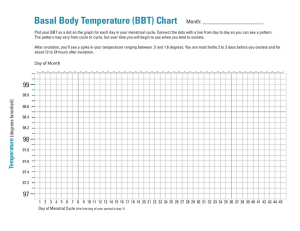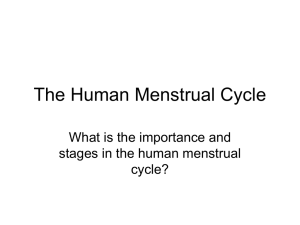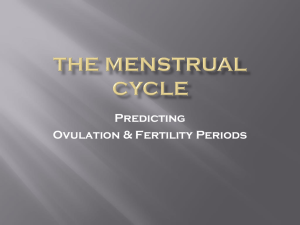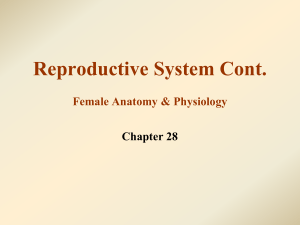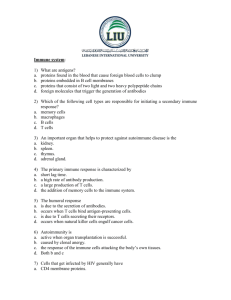Medications for Inducing Ovulation
advertisement
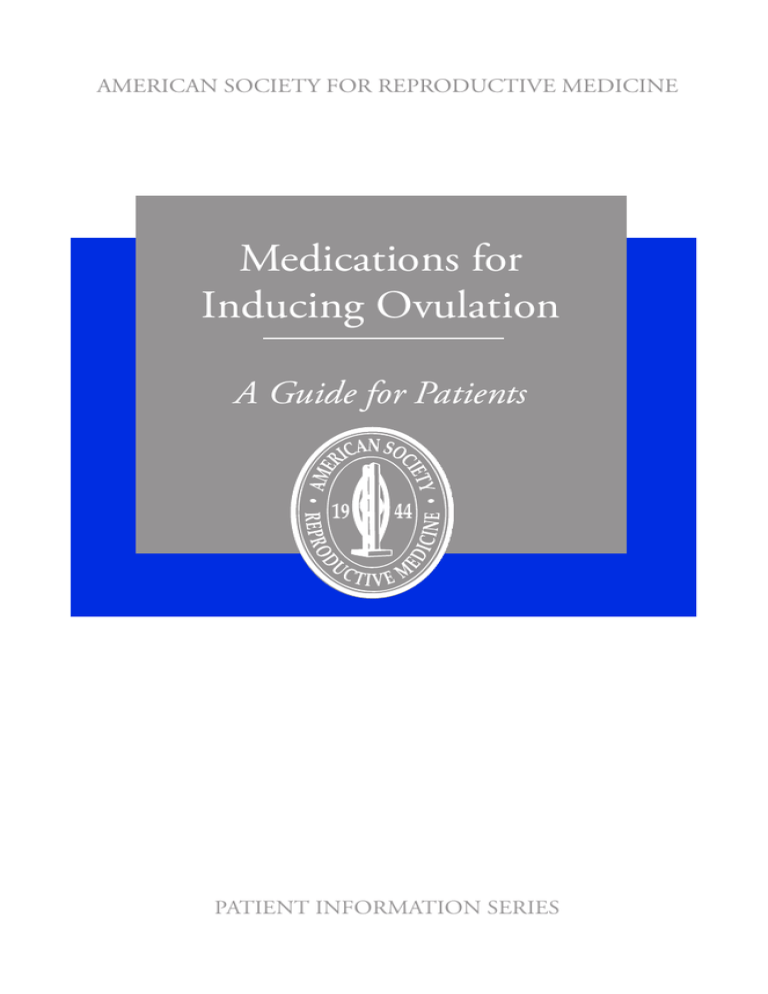
AMERICAN SOCIETY FOR REPRODUCTIVE MEDICINE Medications for Inducing Ovulation A Guide for Patients PATIENT INFORMATION SERIES Published by the American Society for Reproductive Medicine under the direction of the Patient Education Committee and the Publications Committee. No portion herein may be reproduced in any form without written permission. This booklet is in no way intended to replace, dictate or fully define evaluation and treatment by a qualified physician. It is intended solely as an aid for patients seeking general information on issues in reproductive medicine. Copyright © 2014 by the American Society for Reproductive Medicine AMERICAN SOCIETY FOR REPRODUCTIVE MEDICINE Medications for Inducing Ovulation A Guide for Patients Revised 2014 A glossary of italicized words is located at the end of this booklet. INTRODUCTION Some women may have difficulty getting pregnant because their ovaries do not release (ovulate) eggs. Fertility specialists may use medications that work on ovulation to help these women get pregnant. There are two common ways these medicines are used: 1) to cause ovulation in a patient that does not ovulate regularly, and 2) to cause multiple eggs to develop and be released at one time. About 25% of infertile women have problems with ovulation. These women may ovulate less often or not at all (anovulation). These medications can help a woman to ovulate more regularly, increasing her chance of getting pregnant. These medicines, sometimes called “fertility drugs”, may also improve the lining of the womb or uterus (endometrium). In some situations, these medicines may be used to cause multiple eggs to develop at once. This is usually desired when women undergo treatment known as superovulation with intrauterine insemination (IUI), in vitro fertilization (IVF), donate their eggs, or freeze their eggs (either as eggs or fertilized eggs [embryos]). This booklet explains the basics of normal ovulation and the diagnosis and treatment of ovulatory problems. The specific uses for several types of ovulation medicines are outlined, along with the intended results and possible side effects of each drug. Normal Reproductive Anatomy The ovaries are two small organs, each about 1½ inches long and 3/4 of an inch wide, located in a woman’s pelvis (Figure 1). The ovaries are attached to both sides of the uterus (womb), usually below the fallopian tubes. At birth, a female has about 1-2 million pre-formed eggs in her two ovaries. Unlike men, who make sperm throughout their life, women are born with all the eggs they will ever have. Most of the eggs die off naturally (just as hair and skin cells die off) with normal aging. By the time a girl reaches puberty 3 Figure 1 Uterus Fertilization usualy occurs here Ovary Fallopian Tube Cervix Egg released (Ovulated) Cervical mucus Vagina Sperm (around age 10-13, on average), she has about 400,000 eggs remaining. As a girl begins to have regular menstrual periods, approximately once a month, an egg matures within a follicle (a fluid-filled cyst in the ovary that contains the egg). When hormone levels reach the correct level, the egg is released from the follicle (ovulated). The fimbriae (finger-like projections) of the fallopian tubes sweep over the ovary and move the released egg into the tube. If sperm are present, the egg is usually fertilized in the tube. The fertilized egg (now called an embryo) begins to divide and travels through the tube and into the uterus where it implants in the endometrium (uterine lining). THE MENSTRUAL CYCLE The menstrual cycle is divided into three phases: the follicular phase, the ovulatory phase, and the luteal phase (Figure 2). The Follicular Phase The follicular phase lasts about 10 to 14 days, beginning with the first day of menstruation and lasting until the luteinizing hormone (LH) surge. During the follicular phase, the hypothalamus (an organ located just above the pituitary gland in the brain) releases gonadotropin-releasing hormone (GnRH). This hormone tells the pituitary gland to release follicle-stimulating hormone (FSH) which travels through the blood to the ovary. Each month, the brain causes the release of FSH to stimulate the development of a number of follicles in the ovaries, each containing a single egg. Ordinarily, only one will become the dominant follicle with its egg reaching full maturity; the rest of the follicles will 4 stop developing and their eggs will die off (called atresia). The dominant follicle increases in size and releases a hormone called estrogen into the bloodstream. The rising levels of estrogen cause the pituitary to slow down the production of FSH. Estrogen also begins to prepare the uterine lining (endometrium) for the possibility of pregnancy. The Ovulatory Phase The ovulatory phase begins with the LH surge and ends with ovulation (release of the egg from the dominant ovarian follicle). As ovulation approaches, estrogen levels rise and trigger the pituitary gland to release a surge of LH. About 32 to 40 hours after the onset of this LH surge, ovulation occurs. The Luteal Phase The luteal phase begins after ovulation and generally lasts about 12 to 16 days. After the egg is released, the now-empty follicle that had contained the ovulated egg becomes known as the corpus luteum. The corpus luteum produces a hormone called progesterone that helps prepare the uterine lining for implantation of the embryo and pregnancy. After the egg is released it is picked up by the fallopian tube where fertilization occurs. If the egg is fertilized by a sperm, the embryo is transported within the tube and reaches Figure 2 Figure 2. Hormonal cycle in women with normal ovulation. The follicular phase is the phase in which the follicle is growing and secreting estrogen. The ovulatory phase is the 48-hour period characterized by the LH surge and the release of the egg (ovulation). The luteal phase is characterized by secretion of large amounts of progesterone and estrogen. 5 the uterus 4-5 days after ovulation. Once in the uterus, it begins to attach to the endometrium (lining of the uterus), a process that is called implantation. About 11-13 days after ovulation, if there is no implantation, ovarian production of progesterone and estrogen starts to fall off. This causes the endometrium to break down and start to shed, resulting in menstruation, also known as the menstrual period. As menstruation starts, a new ovarian cycle starts with now increasing levels of FSH from the pituitary stimulating the growth of another group of ovarian follicles. DIAGNOSIS A woman who has regular periods every month is probably also ovulating each month with ovulation occurring about 14 days before the first day of each menstrual period. However, it is important to remember that a woman can have uterine bleeding even though she never ovulates. There are several ways to detect ovulation, including home ovulation prediction kits that measure the LH surge before ovulation actually occurs. Basal body temperature (BBT) charts can track the rise in temperature that follows ovulation). Other tests include measuring luteal-phase blood progesterone levels, ultrasound monitoring of ovarian follicles, and endometrial biopsy to detect effects of progesterone on the endometrium (the later test is rarely done any longer). TREATMENT: OVULATION MEDICATION Who Needs Ovulation Medication? Women with irregular menstrual (oligo-ovulatory) cycles or no menstrual periods (amenorrhea or anovulation) are likely to have ovulatory dysfunction. In these women, medications can be used to cause regular ovulation. Before medicines are given, the doctor should try to determine the cause of the problem with ovulation. Some possible reasons for ovulation problems include polycystic ovary syndrome (PCOS), low production of LH and FSH by the pituitary, ovaries that do not respond to normal levels of LH and FSH, thyroid disease, increased levels of the hormone prolactin (hyperprolactinemia), obesity, eating disorders or extreme weight loss and/ or exercise. Sometimes the cause cannot be identified for certain. Women with ovulatory dysfunction typically benefit from ovulation induction with fertility drugs. Ovulation induction with fertility drugs is also used in patients without ovulatory dysfunction. The goal is to stimulate the ovaries to produce more than one follicle per cycle leading to the release of multiple eggs in the hope that at least one egg will be fertilized and result in a pregnancy. This is called controlled ovarian stimulation (COS), or superovulation, and may be 6 accomplished with medicines taken by mouth or by injection. COS combined with either intercourse or intrauterine insemination (IUI) is commonly used as an initial treatment for several types of infertility when the woman has open fallopian tubes. COS is also an important part of most IVF treatment. Before using fertility drugs for COS, it is recommended to make sure the fallopian tubes are unblocked and open. This can be confirmed by injecting dye into the fallopian tubes (Hysterosalpingogram [HSG]) or using a lighted telescope to look inside the lower belly (laparoscopy). For more information on HSG and laparoscopy, please see the ASRM fact sheets titled, Hysterosalpingogram and the booklet titled, Laparoscopy and hysteroscopy. Patients with blocked fallopian tubes will not become pregnant with fertility drugs or may be at risk for an ectopic pregnancy (pregnancy outside the uterus). Patients with blocked fallopian tubes should not undergo ovulation induction unless the purpose of the ovulation induction is to collect the eggs in preparation for IVF. Before starting superovulation induction, the male partner should have a semen analysis to help decide whether ovulation induction should be combined with intercourse, IUI, or IVF. For more information on IVF, consult the ASRM patient information booklet titled, Assisted Reproductive Technologies. COMMONLY PRESCRIBED MEDICATIONS The most commonly prescribed ovulation drugs are clomiphene citrate (CC), aromatase inhibitors (such as letrozole), and gonadotropins (FSH, LH, human menopausal gonadotropin (hMG), chorionic gonadotropin (hCG)). Other medicines used in ovulation induction include bromocriptine, cabergoline, GnRH, GnRH analogs, and insulin-sensitizing agents which have very specialized applications that are described after Table 1, which provides a summary of common ovulation drugs and their side effects (next page). Clomiphene Citrate (CC) Clomiphene is the most commonly prescribed ovulation-induction drug used to stimulate ovulation in women with infrequent ovulation or amenorrhea. It also is used to induce more than one follicle to develop in conjunction with IUI as a treatment for unexplained infertility and for those who are unable or unwilling to pursue more aggressive therapies. The standard dosage of CC is 50-100 milligrams (mg) of clomiphene per day for five consecutive days. Treatment begins early in the cycle, usually starting on the second to fifth day after menstruation begins although it can also be 7 Table 1.Ovulation drugs and their most common side effects 8 started without a period if the woman is anovulatory. If a woman does not have periods, a period can be induced by taking an oral progestin for 5-12 days. Clomiphene works by causing the pituitary gland to make more FSH. The higher level of FSH stimulates one or more follicles to develop (each containing a single egg). As the follicles grow, they secrete estrogen into the bloodstream. About a week after the last dose of CC is taken, the higher levels of estrogen cause the pituitary to release an LH surge. The LH surge causes the egg(s) in the dominant follicle(s) to be released. It is important to determine whether the dose of CC given results in ovulation. This can be done using the menstrual pattern, ovulation prediction kits, measurement of blood progesterone levels, or the basal body temperature chart to monitor a patient’s response to the given dose of clomiphene. If ovulation does not occur at the 50-mg dose, CC is increased by 50-mg increments in immediate or subsequent cycles until ovulation happens. More than 200 mg each day for five days is usually not helpful, and patients who do not ovulate on a clomiphene dosage of 200 mg tend to respond better to a different treatment, such as injections of gonadotropins. Your doctor will determine the appropriate dose for you. Occasionally, the doctor may choose to add other medicines to a CC regimen if the drug does not induce ovulation. For more information about detecting when ovulation has happened, refer to the ASRM Patient Fact Sheet titled, Ovulation Detection. Depending on the timing of the menstrual cycle compared with the time of ovulation, the cervical mucus can either help sperm enter the uterus or act as a barrier. Under the influence of estrogen before ovulation, the mucus is thin and stretchy which helps sperm. In the days following ovulation, when progesterone levels rise, the mucus becomes thick and tenacious. CC can alter cervical mucus, making it thicker. IUI can be used along with CC to help overcome this. CC sometimes can alter thickness of the uterine lining, making it thin and less receptive to implantation. For this reason, the lowest dose of CC that causes ovulation in anovulatory women is usually prescribed. CC will induce ovulation in about 80% of properly selected patients. Once the CC dose that induces ovulation is established, three ovulatory CC cycles are an adequate trial for most patients and may be continued for up to six cycles. However, studies show that CC should not be given for more than six cycles, because the chance of pregnancy is very low and alternative treatments should be considered. \ 9 CC is generally not effective for women who have irregular or absent ovulation due to disorders of the hypothalamus (such as those associated with severe weight loss) or very low estrogen levels (such as those with non-functioning ovaries). In addition, women who are obese may have better success after weight loss. CC is generally tolerated well. Side effects are relatively common, but generally mild. Hot flashes occur in about 10% of women taking clomiphene, and typically disappear soon after the last pill is taken. Mood swings, breast tenderness, and nausea also are common. Severe headaches or visual problems (such as blurred or double vision) are uncommon and virtually always reversible. In the event that these severe side effects occur, treatment should be stopped immediately and the patient should inform her physician. It is not advisable to reattempt any further exposure to CC in these cases. Women who conceive using CC have approximately a 5-8% chance of having twins. Triplet and higher-order pregnancies are rare (<1%), but may occur. Ovarian cysts, which can cause discomfort, may form but typically resolve with time. A pelvic exam or ultrasound may be done if indicated to look for ovarian cysts before beginning another CC treatment cycle. Side effects are more frequent with higher doses. Aromatase Inhibitors Aromatase inhibitors are medicines that temporarily decrease estrogen levels, which cause the pituitary gland to make more FSH. Two medicines, letrozole and anastrozole, are currently FDA-approved to treat breast cancer that occurs after menopause, but have also been used to induce ovulation in women with ovulatory problems. Treatment begins early in the cycle, usually starting on the second to fifth day after menstruation begins although it also can be started without a period if the woman is anovulatory. The typical dose is 2.5- 5 mg daily for five days. Studies show that pregnancy rates with aromatase inhibitors are similar to CC rates, and may be better in certain ovulation disorders such as polycystic ovary syndrome (PCOS). Similar to CC, it can be used to cause more than one follicle to develop for fertility treatments with superovulation-IUI, with similar success rates with CC combined with IUI. Recent research has not shown any increased risk for birth defects in children whose mothers took letrozole for fertility treatment. Insulin Sensitizing Drugs Insulin resistance and the associated high levels of insulin in the blood (hyperinsulinemia) are seen commonly in women with polycystic ovary syndrome (PCOS). Although most women with PCOS will ovulate with clomiphene, some will not (“clomiphene resistant”) and ultimately require an 10 alternate or additional treatment. When used by themselves for 4-6 months, insulin-sensitizing agents such as metformin can cause regular menstrual periods and ovulation in some women with PCOS. Insulin-sensitizing agents are not currently approved by the FDA for this purpose; they are approved to treat type 2 diabetes by improving the body’s sensitivity to insulin. Some PCOS patients do not ovulate in response to either CC or metformin alone but may respond when the two drugs are used together. In a large study sponsored by the National Institute of Child Health and Human Development (NICHD), metformin alone helped fewer couples conceive than CC by itself or metformin and CC combined. This is in contrast to an Italian study which showed metformin to be more effective. However, CC is typically considered the first-line medication in the United States. The most common side effects are gastrointestinal, and include nausea, vomiting, and diarrhea. Metformin therapy is uncommonly associated with liver dysfunction in infertile women, and, in very rare cases, a severe condition called lactic acidosis. Blood tests to check liver and kidney function should be done periodically. Other drugs used for diabetics that improve insulin sensitivity, such as rosiglitazone and pioglitazone, also have been used for this purpose. For more information, please see the ASRM Fact Sheet titled Insulin Sensitizing Agents and PCOS. Gonadotropins Gonadotropins are fertility medications that contain FSH or LH alone or together. Unlike CC, aromatase inhibitors, and insulin-sensitizing agents which are taken by mouth, gonadotropins are delivered by injection. There are a variety of gonadotropin preparations, and others are in various stages of research and development. Because of rapid changes in the international marketplace, the medicines named in the sections below may not include all those available in the United States and worldwide. Gonadotropins might be prescribed for anovulatory women who have tried CC without conceiving. They also are used to help women whose pituitary gland does not produce enough FSH and LH. Gonadotropins are used to cause multiple follicles to develop simultaneously for fertility treatments with superovulationIUI and IVF. It is important to note that using gonadotropins does not “use up” more eggs than a nonmedicated menstrual cycle. Gonadotropin therapy can rescue the eggs that would normally die off allowing those eggs to also mature and be available for retrieval or conception. For non-IVF superovulation cycles, the gonadotropin treatment usually begins on day two or three of the menstrual cycle and the usual starting dose is 75 to 150 IU injected daily. Typically, seven to 12 days of stimulation is enough 11 but this may be extended if the ovaries are slow to respond. The size of the follicles is monitored with ultrasound, and the blood estrogen level also may be measured frequently, both during the stimulation phase of treatment. If blood estrogen levels do not rise and ultrasound shows that the ovaries are not responding to gonadotropins, the dose may be increased, or, less commonly, the cycle may be cancelled. The goal is to attain one or more mature follicles and an appropriate estrogen level so that ovulation can be triggered by hCG to mimic the natural LH surge. If too many follicles develop, or if the estrogen level is too high, the doctor may decide to withhold the hCG injection rather than risk the development of ovarian hyperstimulation syndrome (OHSS) or a high-order (more than twins) multiple pregnancy. Human Chorionic Gonadotropin (hCG) hCG is similar in chemical structure and function to LH. An injection of hCG mimics the natural LH surge and causes the dominant follicle to release its egg and ovulate. The doctor may use ultrasound and blood estrogen levels to determine when to give hCG. Ovulation will usually occur about 36 hours after hCG is administered. hCG is typically used to trigger ovulation with gonadotropins, and may be used when CC or aromatase inhibitors are used to induce ovulation. It is important to remember that a pregnancy test works by detecting hCG; in a pregnant woman, hCG is produced by the implanting embryo and developing placenta. Pregnancy tests (either blood or urine) may be falsely positive if done less than 10 days after an hCG is given to trigger ovulation since the residual hCG is still present. Side effects of gonadotropins As with all medicines, there are potential risks and complications associated with the use of gonadotropins. Side effects should be discussed before taking these (and any other) drugs. One of the most common risks is becoming pregnant with more than one fetus (multiple pregnancy). Up to 30% of gonadotropin-stimulated pregnancies are multiple. Of these multiple pregnancies, about two-thirds are twins and one-third are triplets or more. Multiple pregnancy holds health concerns for the mother and babies. Premature delivery is more common in multiple pregnancies; the greater the number of fetuses in the uterus, the greater the risk. Premature delivery can be associated with serious health consequences for the newborn such as severe breathing problems, bleeding within the brain, cerebral palsy, infections, and even death. For women who are pregnant with more than twins (such as triplets, quadruplets or a higher number of fetuses), a procedure known as multifetal pregnancy reduction is an option that can help reduce the risk of problems resulting from a high-order multiple pregnancy. 12 In addition to problems associated with high-order multiple gestation, another serious possible side effect of gonadotropin therapy is ovarian hyperstimulation syndrome (OHSS). In OHSS, ovaries become swollen and painful. In severe cases, excessive fluid collects in the abdominal cavity (ascites) and occasionally in the chest. In up to 2% of gonadotropin cycles, hyperstimulation may be severe enough to require hospitalization. Careful monitoring with ultrasound, measurement of serum estrogen levels, and adjustment of gonadotropin dosage will help the doctor to identify risk factors and decrease the risk of severe OHSS. When serum estrogen levels are rising quickly, are too high, or an excessive number of ovarian follicles develop, one of several strategies can be used to decrease the chance or severity of OHSS. Gonadotropin stimulation can be stopped and hCG administration delayed until estrogen levels plateau or decline (“coasting”). Alternately, hCG can be completely withheld so that ovulation fails to occur. Another strategy in women not on Leuprolide Acetate (Lupron) is to substitute a GnRH agonist for hCG to trigger ovulation, thereby dramatically decreasing hyperstimulation risks. Other potential side effects of gonadotropin treatment include breast tenderness, swelling or rash at the injection site, abdominal bloating, mood swings, and mild abdominal pain. Some women experience mood swings during gonadotropin therapy, although usually less severe than those that occur with CC. It is difficult to separate the emotional changes due to the hormone levels seen during gonadotropin therapy from the stress associated with fertility treatment. Regardless of the cause, a change in mood is not uncommon during gonadotropin therapy. Bromocriptine and Cabergoline Some women ovulate irregularly or not at all because their pituitary gland secretes too much prolactin. Higher-than-normal blood levels of prolactin (hyperprolactinemia) inhibit the release of FSH and LH, leading to disruption of development of a dominant follicle and ovulation. In some women, high prolactin levels can result from a benign tumor that is composed of prolactin secreting cells, called an adenoma. High prolactin levels also can result from the use of certain drugs such as tranquilizers, hallucinogens, painkillers, alcohol, and, in rare cases, oral contraceptives. Diseases of the kidney or thyroid may also raise prolactin levels. Hyperprolactinemia often is treated with bromocriptine or cabergoline which act by reducing the amount of prolactin released by the pituitary gland. Blood prolactin levels return to normal in 90% of patients who take these 13 medications. Bromocriptine is typically taken daily .Cabergoline is taken twice weekly. Of the women treated, approximately 85% will ovulate and can become pregnant if no other causes of infertility are present. Treatment is usually discontinued once pregnancy is achieved. Women who do not ovulate after their prolactin levels are normal may also be started on CC or gonadotropins. Possible side effects of bromocriptine and cabergoline include nasal congestion, fatigue, drowsiness, headaches, nausea, and vomiting, fainting, dizziness and decreased blood pressure. For most patients, adjusting the dosage can minimize or eliminate these side effects. Some doctors start their patients on a very low dose and increase it gradually in an effort to prevent side effects. The risk of multiple pregnancies is not increased as a result of bromocriptine or cabergoline therapy when taken without other fertility medications. Gonadotropin-releasing Hormone (GnRH) GnRH is released from the hypothalamus in small amounts about once every 90 minutes. The pulsatile (rhythmic) release of GnRH from the hypothalamus into the blood stream stimulates the pituitary gland to secrete FSH and LH. If GnRH is not being released properly, it can be given as a series by a special drug-delivery system that includes a belt holding a lightweight pump. The pump delivers a small amount of GnRH every 60 to 90 minutes through a needle placed beneath the skin (usually in the abdomen) or into a blood vessel. The risk of multiple births and OHSS, are quite small. At present, GnRH is not available for this use in the United States. GnRH Analogs (Agonists and Antagonists) GnRH analogs (agonists) are synthetic hormones similar to natural GnRH, but which are chemically modified to change their function (typically making them last longer). Leuprolide acetate, nafarelin acetate, and goserelin acetate are GnRH agonists. The normal pulsatile rhythmic release of GnRH from the hypothalamus stimulates the pituitary gland to secrete FSH and LH. However, when a woman takes a GnRH agonist, her pituitary gland is exposed to a constant, rather than a pulsatile, pattern of synthetic GnRH. This steady exposure causes an initial rise in FSH and LH production followed by a decline in further release and thereby prevents spontaneous ovulation. Ganirelix and cetrorelix acetate are GnRH antagonists, which immediately suppress the production of FSH and LH without the initial rise in production that is seen with agonists. 14 Both agonists and antagonists are ineffective when taken orally. Both GnRH agonists and antagonists can prevent ovulation from occurring spontaneously which allows eggs to be retrieved from developing follicles and used with virtually all IVF cycles. The patient taking a GnRH antagonist or agonist long-term may have temporary side effects of menopause, including hot flashes, mood swings, and vaginal dryness. In addition, headaches, insomnia, decreased breast size, pain during intercourse, and bone loss may occur with long-term use. These side effects are temporary as the effects on the pituitary are reversed after GnRH analogs are discontinued. LONG-TERM RISKS OF OVULATION DRUGS After years of clinical use, doctors can advise patients confidently that CC and gonadotropins are not associated with an increased risk of birth defects. It is also clear, after years of study, that women taking ovulation-inducing drugs such as CC and gonadotropin may not be at increased risk for ovarian cancer. Long-term data about the use of aromatase inhibitors is accumulating and, is also reassuring. CONCLUSION Infertility due to disorders with ovulation can often be corrected with various fertility treatments that lead to the growth and development of a mature egg that will ovulate. Many of the medications used to induce ovulation can also be used to grow multiple eggs at once (superovulation) in conjunction with additional treatments, such as IUI and IVF to treat other types of infertility. For more information on this and other reproductive health topics, visit www.ReproductiveFacts.org Let us know what you think. Email your comments on this booklet to asrm@asrm.org. In the subject line, type, “Attention: Patient Education Committee.” 15 GLOSSARY Amenorrhea. Absence of menstrual periods. Anovulation. A state of failure to ovulate; this can be transient or chronic. Biopsy. A tissue sample taken for microscopic examination. Controlled ovarian stimulation (COS). Administration of fertility medications in order to achieve the development of two or more mature follicles. Also called superovulation. Corpus luteum. A mature follicle that has collapsed after releasing its egg at ovulation. The corpus luteum secretes progesterone and estrogen during the second half of a normal menstrual cycle. The secreted progesterone prepares the lining of the uterus (endometrium) to support a pregnancy. Embryo. The earliest stage of human development after a sperm fertilizes an egg. Endometrium. Uterine lining that sheds monthly to produce a menstrual period. Estrogen. The female sex hormone produced by the ovaries that is responsible for the development of female sex characteristics. Estrogen is largely responsible for stimulating the uterine lining to thicken during the first half of the menstrual cycle in preparation for ovulation and possible pregnancy. It also is important for healthy bones and overall health. A small amount of this hormone also is made in the male testes. Fallopian tubes. A pair of hollow tubes attached one on each side of the uterus. The egg travels from the ovary to the uterus through narrow passageways within these tubes. Fimbriae. The finger-like projections of the fallopian tubes that sweep over the ovary and move the egg into the tube. Follicle. A fluid-filled cyst located just beneath the surface of the ovary, containing an egg (oocyte) that is surrounded by hormone producing cells (granulosa cells). The sac increases in size and volume during the first half of the menstrual cycle, and at ovulation, the follicle matures and ruptures, releasing the egg. As the follicle matures, it can be visualized by ultrasound. Follicle Stimulating Hormone (FSH). Produced by the pituitary gland, FSH is the hormone responsible in women for stimulating ovarian follicles to grow, stimulating egg development and the production of estrogen. In men, FSH travels through the bloodstream to the testes and helps stimulate them to produce sperm. FSH can also be given as a medication. Follicular phase. The first half of the menstrual cycle (beginning on day one of bleeding) during which the dominant follicle secretes increasing amounts 16 of estrogen. Gonadotropin-releasing Hormone (GnRH). The natural hormone secreted by the hypothalamus that prompts the pituitary gland to release FSH and LH into the bloodstream, which in turn stimulate the ovaries to produce estrogen and progesterone (FSH), and to ovulate (LH). Human chorionic gonadotropin (hCG). A hormone produced by the placenta during pregnancy that mimics the LH surge. It is often used with clomiphene or hMG to cause ovulation. Hyperprolactinemia. High levels of prolactin in the bloodstream. Hypothalamus. A thumb-sized area in the brain that controls many functions of the body, regulates the pituitary gland, and releases GnRH. Hysterosalpingogram. An X-ray performed after dye is injected into the uterus and fallopian tubes to determine if both fallopian tubes are open and if the shape of the uterine cavity is normal. In vitro fertilization (IVF). A method of assisted reproduction that involves surgically removing an egg from the woman’s ovary and combining it with sperm in a laboratory dish. If the egg is fertilized, resulting in an embryo, the embryo is transferred to the woman’s uterus. Insemination. The deposit of semen through a syringe within the uterine cavity or cervix to facilitate fertilization of the egg. Laparoscopy. A surgery performed in which a thin camera is inserted into the abdomen through a small incision to inspect the condition of the pelvic organs. LH surge. The secretion, or surge, of large amounts of luteinizing hormone (LH) by the pituitary gland. This surge is the stimulus for ovulation to occur. Luteal phase. The second half of the menstrual cycle after ovulation when the corpus luteum secretes large amounts of progesterone as well as estrogen. Luteal phase defect. A shorter than normal luteal phase or one with lesser progesterone secretion despite a normal duration. Luteinizing hormone (LH). The hormone that triggers ovulation and stimulates the corpus luteum to secrete progesterone. Multifetal pregnancy reduction. Also known as selective reduction. A procedure to reduce the number of fetuses in the uterus. This procedure may be considered for women who are pregnant with multiple (more than two) fetuses. As the risk of extreme premature delivery, miscarriage (spontaneous abortion), and other problems increases with the number of fetuses present, this procedure may be performed in an attempt to prevent the entire pregnancy from miscarrying (aborting). Ovarian hyperstimulation syndrome (OHSS). A possible side-effect of controlled ovarian stimulation treatment with fertility medications, particularly injectable hormones, in which the ovaries become enlarged due 17 to development of many follicles, are painful and swollen, and fluid may accumulate in the abdomen and chest. Ovarian reserve. Quantity of eggs available at any age and reflects a woman’s fertility potential. Diminished ovarian reserve is associated with depletion in the number of eggs and also may be associated with worsening of egg quality. Ovulation. The expulsion of a mature egg from its follicle in the outer layer of the ovary. It usually occurs on approximately day 14 of a 28-day cycle. Pituitary gland. A small gland just beneath the hypothalamus that secretes follicle stimulating hormone and luteinizing hormone, which stimulate egg maturation and hormone production by the ovary. Polycystic ovary syndrome (PCOS). A condition characterized by chronic anovulation, excessive ovarian production of testosterone and/or ovaries with many small cystic follicles. Symptoms may include irregular or absent menstrual periods, obesity, infertility, excessive hair growth, and/or acne. Progesterone. A female hormone secreted by the corpus luteum after ovulation during the second half of the menstrual cycle (luteal phase). It prepares the lining of the uterus (endometrium) for implantation of a fertilized egg and allows for complete shedding of the endometrium at the time of menstruation. In the event of pregnancy, the progesterone level remains stable beginning a week or so after conception. Progestin. A synthetic hormone that acts similar to progesterone. Prolactin. A pituitary hormone that stimulates milk production and interferes with ovulation by inhibiting FSH and LH release. Superovulation. Administration of fertility medications in order to achieve the development of two or more mature follicles. Also called controlled ovarian stimulation. Ultrasound. High frequency sound waves that produce an image of internal organs on a monitor screen. Uterus (womb). The muscular organ in the pelvis in which an embryo implants and grows during pregnancy. The lining of the uterus, called the endometrium, produces the monthly menstrual blood flow when there is no pregnancy. 18 19 AMERICAN SOCIETY FOR REPRODUCTIVE MEDICINE 1209 MONTGOMERY HIGHWAY BIRMINGHAM, ALABAMA 35216-2809 (205) 978-5000 • ASRM@ASRM.ORG WWW.ASRM.ORG • WWW.REPRODUCTIVEFACTS.ORG
